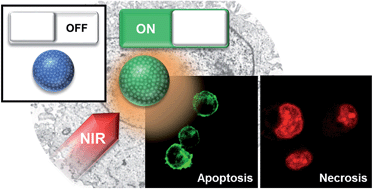Pseudo metal generation via catalytic oxidative polymerization on the surface of reactive template for redox switched off–on photothermal therapy†
Abstract
The integration of contrast-enhanced diagnostic imaging and therapy could utilize image guided therapy to plan treatment strategy. Toward this goal, a unique construction and operation of a pseudo metal based photothermal therapeutic agent (PPAM) is introduced by polyaniline (PANI) generation templated on iron oxide metal nanoclusters (MNCs). Notably, MNC core interferes as a catalytic agent and enables aniline polymerization under ambient acidic conditions. The intrusion of transition metal enhanced the proton sensitivity of PANI, which led to pH responsive conversion even at dilute proton concentrations (pH 5, 6) compared to the PANI particles prepared by conventional methods. Under physiological pH, PPAM reveals no special features; however, under low pH conditions, which is a notable characteristic of the cancer microenvironment, PPAM automatically converts into its emeraldine salt (ES) state and thus activates as a photothermal therapeutic agent. Utilizing this specific redox responsive switched off–on behavior of PPAM, precise and systemized photothermal therapy is demonstrated, proving itself as a smart and efficient photothermal therapeutic agent.


 Please wait while we load your content...
Please wait while we load your content...